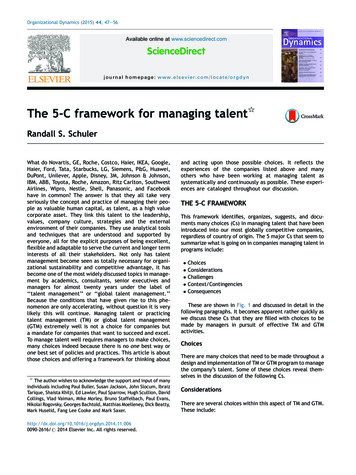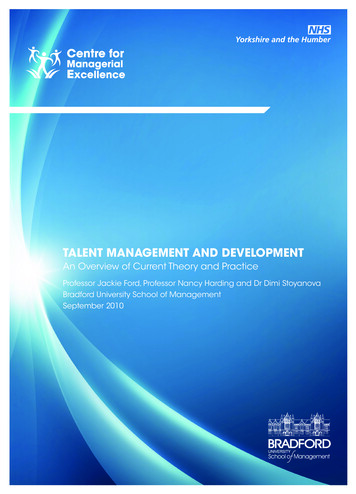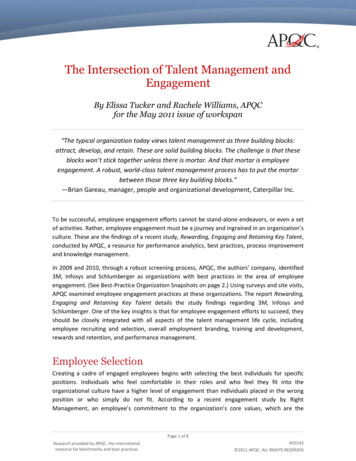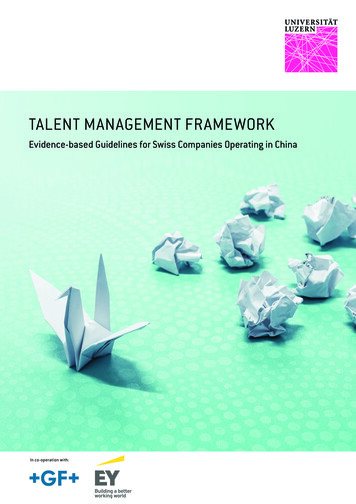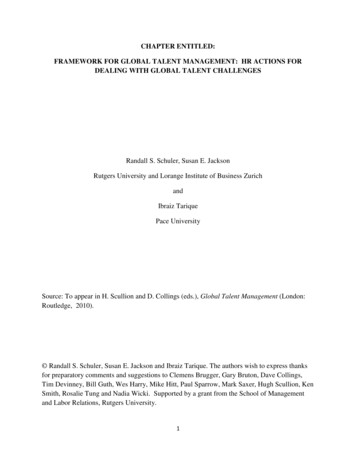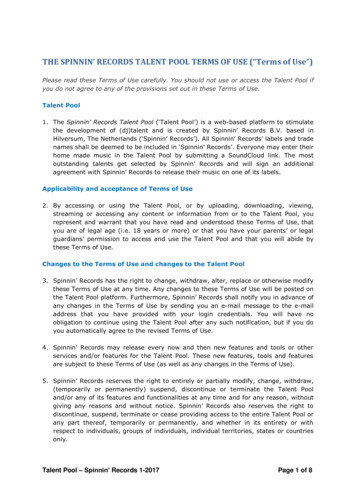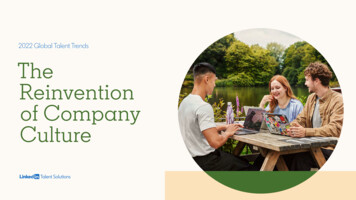
Transcription
2022 Global Talent TrendsTheReinventionof CompanyCulture
What’s in this report0312274257Why companyculture is beingreinventedFlexibilityWell-beingThe Great ReshuffleThanks to thecontributorsLinkedIn Global Talent Trends 20222
IntroductionA watershed momentfor company cultureThe management guru Peter Drucker famously preached:“Culture eats strategy for breakfast.”Except he probably didn’t, given no one has found asupporting citation. Perhaps the visionary Drucker saw wherebusiness was headed: to a place where culture and strategyare inseparable, twin pistons driving the same engine.Company culture is having a watershed moment. It isbeing reshaped in a crucible fired by the pandemic, theacceleration of automation, the rise of millennials and GenZ in the workforce, and the Great Reshuffle. Employees aredemanding — and quite often getting — more freedom towork where and when they want and more attention to theirwell-being.LinkedIn Global Talent Trends 20223
IntroductionThe human-centered company culture being forged hassome recurring characteristics: flexibility, asynchrony, trust,belonging, and a holistic focus on well-being.“We’re seeing people wanting much more flexibility so thatthey can fit work into their personal lives,” says Mary AliceVuicic, the CHRO of Thomson Reuters, “as opposed to fittingtheir personal lives into work.”Adds Claude Silver, the chief heart officer at VaynerMedia:“We have been all about work-life balance. We are wakingup to a collective aha moment. This is backward. It should belife-work balance.”For companies to attract, retain, and grow the talent that willbring them sustained success, they need to fine-tune — oroverhaul — their culture to meet the expectations ofprofessionals to be seen as human beings first.We talked to two dozen leading talent professionals aroundthe world and reviewed proprietary LinkedIn data taken frommillions of employee engagement surveys and billions of actionson our platform to understand how a caring culture has becomethe pivotal asset for companies worldwide.Read on to find out what happens when culture and strategyfind alignment.A 2021 survey by LinkedIn of what matters most to job seekersaround the world found that the No. 1 employee valueproposition is good work-life (all right, life-work) balance,followed by excellent compensation and benefits.Gone are the days when companies could lead with perks— think ping-pong tables and endless snacks — designedto make the office a home away from home. Today, forwardthinking organizations are working with employees to makehome an office away from office.LinkedIn Global Talent Trends 20224
Culture is very important because people know that they have choicesand their choices are beyond the name of the company or the salary thatthey make. Their choices are around enrichment, their choices are aroundwho am I learning from. How is my soul being fed? And they are willing toexchange money and location for feeling fulfilled.Judy JacksonGlobal Head of Culture and Engagement, WPPLinkedIn Global Talent Trends 20225
Work-life balance trumps evenbank balance for job seekersPercentage of professionals selecting these as top priorities when picking a new job:63%60%Work-life balanceCompensationand benefitsLinkedIn Global Talent Trends 202240%Colleaguesand culture6
Improving company culture startswith professional developmentPercentage of respondents selecting these as topareas to invest in to improve company culture:Professional developmentopportunities59%Flexible work support48%Mental health and wellness42%Training managers to leadremote and hybrid teams35%Diversity and inclusion26%0%LinkedIn Global Talent Trends 202225%50%75%7
United nations:Everyoneis lookingfor strongercompanyculturePercentage of candidates whoconsider company culture a toppriority when picking a job:Global Average40%Top 3MidrangeNetherlandsSpain45%50%Canada42%Australia andNew Zealand47%U.K.45%U.S.41%France46%Southeast %Bottom 3LinkedIn Global Talent Trends 20228
The evolution of company culture1940s1950sRigid hierarchies andsmoking in the officeThe post-WWII decade saw companiesorganized into strict hierarchies reflectedin workplace design. Workers huddled inbullpen-style open floor plans as businessessought to increase productivity anddecrease privacy. Elusive corner offices withbig windows were reserved only for bosses.Women — displaced from jobs filled duringWWII — were largely absent or served inlow-level positions. Ever present, though,were the steady stream of cigarette smoke inthe office and three-martini lunch breaks.LinkedIn Global Talent Trends 20221960s1970sWomen rise in theworkplace; dress codesloosen upThe passage of anti-discrimination laws,access to birth control, and societalchanges drove women into the workforce.Women started to occupy jobs that hadtypically been filled by men — from bluecollar work to managerial roles. Hippieculture left its mark, with men adoptinglonger hairstyles. Women, in turn, traded intheir skirts for pants.9
The evolution of company culture1980s1990sRelationships betweenworkers and bosses frayAs companies looked to cut costs, workersfound themselves vulnerable to downsizingsand layoffs. Employees no longer felt a senseof job security or company loyalty. Officeworkers sat in claustrophobic cubicles, onlyadding to their low morale. The suffocatingoffice experience inspired the cult classicmovie Office Space, a sarcastic testamentto the era.LinkedIn Global Talent Trends 20222000s2010sTech startup culturerevolutionizes theworkplaceSilicon Valley tech startup Google andothers redefined company culture,creating a blueprint that would influencecompanies across industries for years tocome. As competition for talent — andthe desire to keep employees onsite— heated up, employers offered amultitude of generous perks, from freefood to massages to nap pods. Cubiclesgave way to open floor plans, reflectingflat organizations that encouragedcollaboration. But while some employersaimed to make the office fun, manyemployees reported working longer hours.10
The evolution of company culture2020s2030s2040s2050sThe era of humanfocused companyculture beginsWorkers are now reevaluating what mattersmost to them in the wake of the COVID-19pandemic, prompting employers to focus onthe well-being and personal satisfaction oftheir employees. Companies are adjustingtheir policies to ensure that employees feelcared about as human beings, not just asworkers, making flexible work arrangementspermanent, investing in wellness programs,and boosting their diversity and inclusionefforts. Employers and employees arebuilding a new, more dynamic relationshipbased on trust and empathy.LinkedIn Global Talent Trends 202211
Chapter 1FlexibilityRethinking when and where we work is building more equitable culturesLinkedIn Global Talent Trends 202212
Flex to the max: The oldway of working is historyas flex culture takes holdIn the future, one-size-fits-all is not likely to fit anyone.“Having everyone in one office space, 9 to 5, seems out of datenow,” says Paddy Hull, vice president of the future of work atUnilever. “Flexibility is the way forward.”Employees want flexibility in where, when, and how they work.And they’re more than willing to head out the door if theirorganization isn’t providing it.“The people who are satisfied that their organization does a goodjob providing work flexibility in terms of time and location,” saysJustin Black, head of people science at LinkedIn, “are 2.6 timesmore likely to be happy working at their company and 2.1 timesmore likely to recommend that others work at their employer.”LinkedIn Global Talent Trends 2022 Flexibility13
Flexibility also serves as a forcing function that drivescompanies away from presenteeism and toward performance.“Organizations,” says Nickle LaMoreaux, CHRO at IBM, “mustmeasure outcomes, not activity.”Once a company couples agency with accountability and startsrewarding results rather than face time, it’s not such a largeleap to something like Flex Appeal, the program launched byinternational staffing agency Austin Fraser. Alice Scott, the firm’schief operations and inclusion officer, describes the initiative as“work where you’re productive, when you’re productive, from dayone, forever.”But that new freedom puts new demands on company culture,which must now deliver equity for every employee, no matterwhere or when they work. Strong, highly functional cultures willwork well no matter what time zone you live in or what time ofday you do your work.Some jobs, of course, can’t (yet) be done remotely. “Flexibility,”Nickle says, “is still the key.” Companies are offering job shares,different shifts, compressed workweeks, and other forms offlexible scheduling to make sure onsite employees can alsoshape work around their personal lives.LinkedIn Global Talent Trends 2022 Flexibility14
Not since the industrial revolution have companies really had tothink about work design, about what tasks get done and where dothose tasks get done, and when and how do you deconstruct workso that it’s done in an optimal manner.Nickle LaMoreauxChief Human Resources Officer, IBMLinkedIn Global Talent Trends 2022 Flexibility15
Employees’ happy placeis the one they chooseWhen employees are satisfied with their companies’ time and location flexibility, they are:2.6xmore likely to reportbeing happyLinkedIn Global Talent Trends 2022 Flexibility2.1xmore likely to recommendworking for the company16
Flexibility is becoming a keyvalue proposition for employers2019 83%increase in job posts mentioningflexibility since 2019 343%2021 35%engagements when a companypost mentions flexibilitymore mentions of flexibilityin company posts since 2019LinkedIn Global Talent Trends 2022 Flexibility17
Flexibility is abestseller for Gen ZDifference in engagement on a companypost mentioning flexibility, relative to theaverage company post:2012Generation Z77%Millennials30%Generation X-5%Baby boomers-31%1997198119651946LinkedIn Global Talent Trends 2022 Flexibility18
Tips to makelocationflexibility workLinkedIn Global Talent Trends 2022 FlexibilityThere’s little doubt that remote work has become thenew normal: Of more than 500 C-level executivesin the U.S. and the U.K. surveyed by LinkedIn, 81%said they are changing their workplace policies tooffer greater flexibility. But establishing an effectivehybrid workforce requires careful planning toensure that remote employees remain productive,feel connected to their coworkers, and are treatedequitably. Here are some approaches worthchecking out:19
#1#2#3Establish guidelinesfor how to treatremote workersCreate a levelplaying field for allemployeesReinforceemployee bondswith virtual eventsDuring the dark days of the pandemic,IBM laid out its policies in a “Workfrom Home Pledge” that encouragedemployees to be “family sensitive,” tobe kind to one another, and to support“not camera ready” times. Today thepledge remains an important reminderof IBM’s culture, where the physicaland emotional health of all employeesare key priorities.When some employees work fromhome, they run the risk of beingoverlooked by their bosses. Butcompanies can prevent bias againstremote workers by taking a methodicalapproach. Research and educationcompany Wiley analyzes promotionsand raises and keeps an eye out forpatterns that might indicate thatremote workers are being left behind.Virtual events are one way to fostersocial connections. VaynerMediainvites its 1,000-plus employees totune into a daily, 15-minute-longprogram called Voices@ONE37pm,featuring academics and celebrities.“It’s been a cultural game-changerbecause it’s bringing everyone togetherfor camaraderie, enjoyment, and aburst of goodness in between theirnormal routines,” says VaynerMedia’sClaude Silver.LinkedIn Global Talent Trends 2022 Flexibility20
#4Have senior leaderswork from homeWhen the company allhands is hosted from theCEO’s living room rather than the companyboardroom, employees understand that remote workis getting some love. “I would rarely go into the office,”says Alice Scott, chief operations and inclusion officerat international staffing firm Austin Fraser. “I would beoffsite with our CEO. We role-modeled it and we usedall of our leaders to say, ‘Talk to your teams and sharehow this is going to work.’”21
Ways tomaximizeflex time atyour companyLinkedIn Global Talent Trends 2022 FlexibilityAs employees have shown they can be trusted to getthe job done during the hours of their choosing, moreemployers are allowing workers to set their ownschedules. “When you give someone choice and itcomes backed with trust and with no consequencesand no small print, I think that’s game-changing,”says Austin Fraser’s Alice Scott. “The effects for ushave been overwhelmingly positive.” Here are someways to offer your employees flex-time options whilestill achieving your business goals:22
#1#2#3Focus on results,not work hoursHelp employeesset boundariesSay goodbyeto live meetingsThe employee who pulled an allnighter may have been a hero in thepast. But in the future, employers willjudge workers based on their abilityto meet goals rather than their hoursspent at a desk. “Companies aregoing to see a pivot around measuringoutcomes — not activity — and that’sgoing to play a big part in companyculture,” says IBM CHRO NickleLaMoreaux.As the parameters of the classicworkday melt away, it’s important forcompanies to remind employees totake breaks. Singapore-based ridehailing company Grab studied thecompany’s Zoom and Slack channelsand noted that employees are workinglonger hours. “We’re trying to askpeople to switch off and make surethey have enough time and balance,”says Ju Min Wong, head of peoplestrategy at Grab.With employees no longer workingsynchronously, it’s time to find newways to communicate. Companieslike Twitter have an “async-first” policy,replacing meetings with other ways oftalking. “Maybe a meeting could be anemail,” says Lars Schmidt, the founderof executive search firm Amplify. “Wedon’t need to be live to discuss this. Wecan use a cloud-based technology toupload notes and collaboratively edita document or resource.”LinkedIn Global Talent Trends 2022 Flexibility23
#4Provide flex timeto frontline workersEmployees in such industries as manufacturing,retail, and healthcare don’t have the option towork remotely. To level the playing field, someemployers are offering these workers flex-timearrangements. “There’s growing interest in fourday weeks, or nine-day-fortnights and staggeredshifts, all of which give frontline workers morechoice and control over their work,” says NikkiSlowey, cofounder of Scotland-based consultingfirm Flexibility Works.LinkedIn Global Talent Trends 2022 Flexibility24
Case StudyUnilever blends full-time andcontract work into somethingnew and provocativeAs a purpose-driven company, Unilever recognized thatemployees want to move beyond traditional fixed-hoursemployment models and are seeking more flexible workarrangements tailored to their personal needs.The company launched a pilot program called U-Work thatcreates a new type of “hybrid” employee who can enjoy theflexibility of being a contract worker as well as some of thesecurity and benefits enjoyed by full-time workers.Rather than having a fixed role, U-Work employees work ondifferent assignments that they choose. In between, they’refree to do the things in life that are important to them. U-Workemployees are paid for each assignment when they’re working.On top of that, they get a monthly retainer and a suite of benefitswhether they’re working on an assignment or not.The program is now live in Malaysia, South Africa, Argentina,Mexico, India, the Philippines, and the United Arab Emirates.In the United Kingdom, it has already attracted 57 employees— 1% of the U.K. workforce — within its first year. Unilever isrolling out the program in Spain, Russia, and Turkey with furtherambitions to expand by 2030.LinkedIn Global Talent Trends 2022 Flexibility25
U-Work catches on across generationsUnilever employees at varying stages in their lives are gravitating to this new way of work. The program isgiving workers more choice while helping Unilever remain competitive. Among those who’ve signed up are:A factory manager nearing retirement whowants to coach younger workersLinkedIn Global Talent Trends 2022 FlexibilityA parent who wants to balance caregiverresponsibilities and workA recent graduate who wants to set up a sidebusiness and travel26
Chapter 2Well-beingTo nurture healthy cultures, companies should provide careand compassionLinkedIn Global Talent Trends 202227
Trade burning the midnightoil for morning yogaCompanies everywhere are discovering that their own wellbeing is inextricably linked to their employees’ well-being —mental, physical, emotional, and financial.“We’re suddenly concerned for employee well-being and thewell-being of our employee’s family,” says Becky Garroch, theVP of people and places at Digital River. “The fact is we are ineach other’s homes now and there’s no longer this separationbetween work and home life. You get the whole human and youneed to think about how you work with, support, and engage thewhole human.”Promoting well-being means offering employees much morethan even health insurance and yoga classes. Today, well-beingstarts with care and compassion.“Empathy must be a pillar of every culture,” IBM’s Nickle says.LinkedIn Global Talent Trends 2022 Well-being28
A critical driver of employee well-being is the flexibility talkedabout earlier in this report. Beyond that, companies are findingmore and more ways to demonstrate care and compassion fortheir workforces, including giving time back, with everythingfrom half-day Fridays to shutdown weeks; offering well-beingservices, such as employee assistance programs (EAPs) andbackup caregiving options; and rethinking processes by, say,shortening or eliminating meetings and better leveragingasynchronous communications like email or chat. All of theseinitiatives address the reality that it’s hard to have a healthy,productive culture without a healthy, productive workforce.But perhaps the biggest single thing companies can do tosupport well-being is to stop glorifying the workaholic andthe 1 a.m. hero.“Individuals have started to realize that there is more totheir lives than just work,” says Rob Allen, the VP of talent andengagement at GitLab. “They want to feel like work is meetingthem halfway and that they’re able to truly have a work-lifebalance as they perceive it.”LinkedIn Global Talent Trends 2022 Well-being29
In the workplace, we shouldn’t value and celebrate the peoplewho stay up all night and burn the midnight oil, becausethat doesn’t really produce great results for the person or theorganization. It’s not a sustainable model.Jen FisherChief Well-Being Officer, DeloitteLinkedIn Global Talent Trends 2022 Well-being30
Employees want a care packageIf employees feel cared for at work, they are:3.2xmore likely to behappy at workLinkedIn Global Talent Trends 2022 Well-being3.7xmore likely to recommendworking for the company31
Well-being content is resonating,especially with women 147% 5% 73% 41%2019increase in the share of job poststhat mention “well-being” since 2019increase in company postsabout “well-being” since 2019LinkedIn Global Talent Trends 2022 Well-being2021more engagements with poststhat mention “well-being”more likely for women toengage with “well-being”company posts, compared tothe average post32
Gen Z wants aculture built onmental healthand wellnessPercentage of people who say that they’dlike to see more investment in mental healthand wellness to improve company culture:2012Generation Z66%Millennials51%Generation X41%Baby boomers31%1997198119651946LinkedIn Global Talent Trends 2022 Well-being33
Ways to helpemployeesachieve betterwork-lifebalanceLinkedIn Global Talent Trends 2022 Well-beingDuring the days of forced lockdowns, as employeesfaced health scares and struggled to balance workand family, employers offered extra days off tohelp ease stress. Today, companies are prioritizingtime off and they’re adopting new strategies toencourage employees to check out and recharge.Here are some ideas to consider:34
#1#2#3Give workers moretime in their dayShut down fora few daysSend the CEOon vacationPeloton urges employees to usean app to block off time in theircalendars to take care of importantpersonal matters. The company alsoencourages its people leaders toestablish “no meeting” periods. Tobattle meeting fatigue, ThomsonReuters has changed the default timeperiods for scheduling meetings fromincrements of 30 or 60 minutes to 25 or45 minutes.Studies show that in some parts of theworld, employees are reluctant to taketheir vacation days. That’s one reasonwhy it’s worth carving out several daysa year to give workers a universal timeoff. Companies including LinkedIn,Nike, Instacart, and Thomson Reutershave already done so. “Unlike vacation,which happens asynchronouslyaround the world, almost everybody inthe company is able to put pens down,devices down, and just take time tofocus on their own health and wellbeing,” says Thomson Reuters’s MaryAlice Vuicic.When senior execs sign off to focuson their own well-being it sends apowerful message. “They can sharedetails of why and how they took timeoff and the impact it had on their wellbeing and even their creativity andproductivity,” Deloitte Chief Well-beingOfficer Jen Fisher and her colleaguesnoted in a blog post. “This type ofsharing can also help erase some ofthe stigma workers may feel abouttaking time off and empower them todo the same.”LinkedIn Global Talent Trends 2022 Well-being35
#4Consider afour-day workweekIs your company ready to scrap the traditional fiveday work model? A small but growing list of employersare — and it could be only a matter of time until theidea gains wider traction. Crowdfunding companyKickstarter recently announced it was piloting afour-day workweek, joining others including fintechcompany Bolt, Spanish fashion company Desigual, andPerpetual Guardian in New Zealand.Some HR leaders believe that as more companiesallow employees to create their own schedules,institutionalizing a four-day workweek won’t benecessary. But others say the workweek is ripe forreinvention. “Whoever cracks the four-day workweek isgoing to win the talent war because that’s going to bethe new in-demand perk,” says Marta Riggins, employerbrand and employee engagement strategic consultant.LinkedIn Global Talent Trends 2022 Well-being36
Ways torethink yourmental healthservicesLinkedIn Global Talent Trends 2022 Well-beingThe rise of millennials in the workforce thrustmental health services to the forefront ofemployee benefits in recent years, and the trendhas only grown stronger during the pandemic.In a tight job market, employers will haveto continue to innovate their mental healthofferings to lure and retain talent. “This becomesan important part of how you differentiateyour company — the care that you have foremployees,” says Richard Cho, head of recruitingat Robinhood. Here are some ideas to consider:37
#1#2#3Train managersto be empatheticleadersMake mentalhealth serviceseasily accessibleUse peopleanalytics toidentify problemsEmployers are training bosses to offeremotional support and to look forsigns of emotional distress. At telecomcompany Axiata, managers are taughtto identify symptoms of burnout andstress, while managers at Wiley areurged to have frequent check-ins withemployees. “Practices like these,” saysDanielle McMahan, Wiley’s chiefpeople and business operationsofficer, “are really critical to not onlyaddress burnout but also build cultureand create a sense of belonging.”Meditation apps like Headspace andCalm and virtual therapy services fromcompanies like Lyra Health surgedin popularity during the pandemic.Now some employers are taking theiremployee assistance programs to anew level. Amazon recently launchedResources for Living, a mental healthplatform whose offerings includesuicide-prevention support and accessto a licensed mental health clinicianany time of the day.Apps such as Microsoft Viva Insights— part of Microsoft Teams — cangive companies a better handle onemployee behavior. Viva Insightslooks at work patterns such as afterhours work and meeting overloadthat might lead to burnout and stress.Managers can identify problems andtake the appropriate action to supportemployee well-being.LinkedIn Global Talent Trends 2022 Well-being38
#4Turn your employeesinto mental health alliesWhen you’re facing emotional challenges,sometimes it helps to talk to a caring coworker.That’s one reason why some employers, includingWPP, Unilever, and Austin Fraser, are starting to offerpeer-to-peer mental health counseling. WPP’s pilotprogram Mental Health Allies allows employees tovolunteer to support their colleagues. The allies takea two-day training course that teaches them thefundamentals of mental health, how to listen withoutjudgment, and how to point their coworkers toservices and resources. WPP has received hundredsof applications from employees eager to volunteer.LinkedIn Global Talent Trends 2022 Well-being39
Case StudyLiftUp! elevates LinkedInemployee well-beingTo help employees make the best of their new work-from-homereality, LinkedIn launched a program in September 2020 calledLiftUp! to address the burnout, anxiety, and social disconnectionthat company leaders had begun noting.LiftUp! features an always-on resource hub, a series of fun events,and — most treasured by employees — the frequent gift of time,including a company-wide shutdown week in April 2021.“The surprises and delights,” says Nina McQueen, VP of benefitsand employee experience at LinkedIn and the main architectof LiftUp!, “were really meant to simply put the spark back ineveryone, lift our heads up higher, and create some fun alongthe way.”Nina and her team have been intentional about making theprogram as inclusive as possible, ensuring that its offerings areas available to employees half a world away as they are to thoseliving near the company’s Silicon Valley headquarters.LinkedIn Global Talent Trends 2022 Well-being40
9/16/20LiftUp!Is launched12/10/20End-of-year“Silver LiningsShow” hostedby Trevor Noah10/30/20Globalwell-beingday off11/3/20The first ofmany monthly“no meeting”days1/1/21Benefits expandto cover homeexerciseequipment (up to 2,000/year)1/22/21A conversationwith actor MatthewMcConaughey4/5/21 – 4/9/21A week off formost employees11/9/20Employees canconvert wellnesspoints into charitydonations10/29/21Global WellBeing Day Off9/1/21Music festivaland COVIDrelief fundraiserLinkedIn Global Talent Trends 2022 Well-being3/10/21Random acts ofkindness for others7/13/21Workshop: “Returning tothe Office: Strategies toKeep Stress in Check”6/23/21Start of half-dayFridays for all ofJuly and August4/7/21Hour-longonline showwith music,magic, andtrivia41
Chapter 3The GreatReshuffleAn epic talent migration prompts companies to reconsidertheir values and employer brandingLinkedIn Global Talent Trends 202242
The Great Reshuffle:Employees are saying,‘We can do better.’Companies can too.The pandemic has spurred employees to prioritize theirwell-being and to seek more agency about where — andwhen — they work. This insistence on a new relationshipwith work is a key trigger for what we call at LinkedIn theGreat Reshuffle, aka the Great Resignation. “It’s a timewhen everyone is rethinking everything,” says LinkedInCEO Ryan Roslansky. “Business leaders are rethinkingtheir entire working models, cultures, and company values.Employees are rethinking not just how they work, but why.”Workers are changing jobs, hoping for something more —more purpose, more flexibility, more empathy.LinkedIn Global Talent Trends 2022 The Great Reshuffle43
Organizations that cling to their old ways may be invitingtalent problems. “They’re going to struggle to hold talent,”says Lars Schmidt, the founder of Amplify. “They’re going tostruggle to recruit talent. They will be the poster children for theGreat Resignation if they’re trying to box their employees intoconstructs they don’t want.”Getting the word out will be key: According to LinkedIn data, jobseekers have become choosier, viewing nearly twice as manyjob posts before applying in 2021 than they did in 2019. So, ratherthan focusing on challenging work, hypergrowth, and unicornambitions, companies may fare better with messaging aroundflexibility, inclusive benefits, and internal mobility rates.Some parts of the world are still struggling with highunemployment, and most workers in those regions areclinging to their jobs. But according to the Microsoft 2021 WorkTrend Index, 41% of global employees said they were likely toconsider leaving their jobs in the following 12 months. And theyweren’t just blowing smoke. Labor shortages have hamperedindustries across the world, from China to Germany to theUnited States, where a record 4.3 million workers quit their jobsin August alone.Success in the Great Reshuffle doesn’t end with attracting andretaining talent. Companies will need to figure out how, in themidst of an epic workforce upheaval, they can preserve andenhance their culture rather than see it erode. For ideas on howto maintain culture as you hire at scale, read on.“This level of quitting,” writes The Atlantic, “is really anexpression of optimism that says, We can do better.”Companies can too. Organizations that rethink and renewtheir cultures — and their employer branding — can win bigin the new battle for talent. From chaos, opportunity.LinkedIn Global Talent Trends 2022 The Great Reshuffle44
Company culture is swiftly evolving, and to keep up, organizationsmust innovate and think progressively. We have
LinkedIn Global Talent Trends 2022 3 A watershed moment for company culture The management guru Peter Drucker famously preached: "Culture eats strategy for breakfast." Except he probably didn't, given no one has found a supporting citation. Perhaps the visionary Drucker saw where business was headed: to a place where culture and strategy



